April: Life will out, everywhere we look
Frontenac State Park Association newsletter
April 2025 (Vol. 3, No. 4)
Comments, contributions, compliments, complaints? Reach your newsletter editor at pamelamarianmiller@gmail.com.
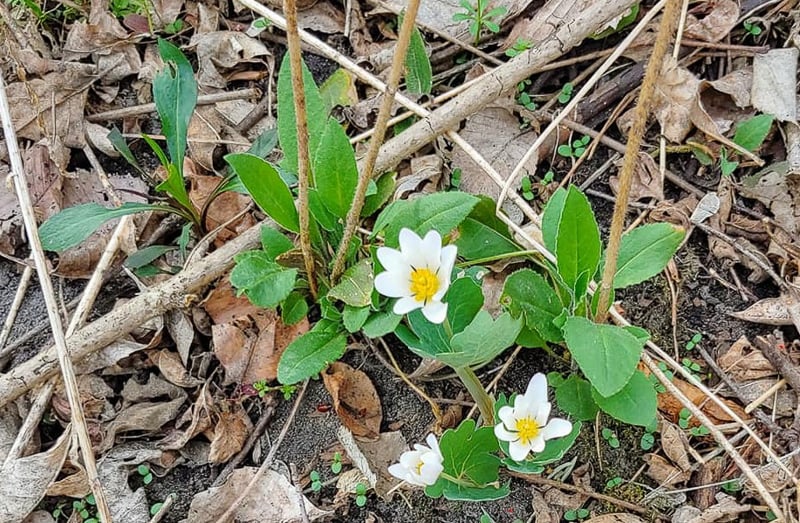
April: Life will out, everywhere we look
The poet T.S. Eliot famously dubbed April “the cruelest month” (he had his reasons —something about hope and despair having a fender-bender — we hope he felt better by May), but for most of us, April brings renewal and relief. The days lengthen and warm, noisy waterfowl soar overhead in formation every few minutes, birds sing with manic passion during the dawn chorus, and the brown and white of winter give way to spring green. Bring it on!
April also means mud – well, we hope it does; we badly need some precipitation around here – so don’t wear your church shoes or Crocs when you come to hike in Frontenac State Park. A walking stick can help you navigate slippery trails. (And don’t forget tick protection — yep, they’re out.) And remember, mud season is nature’s incubator.
Mud and … fire. Let’s consider fire for a moment.
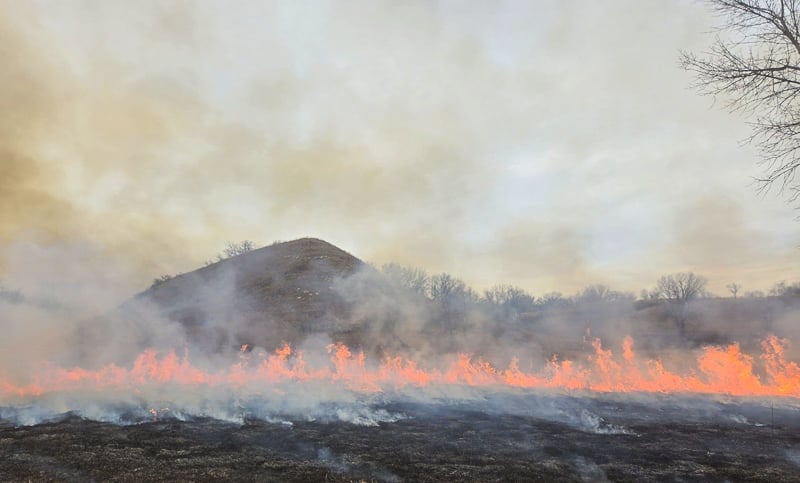

April also marks the second anniversary of this newsletter. A reminder that you can find past issues at our website, with lots of evergreen seasonal stories and photos about animals, birds, plants and fungi that live in the park. We hope you enjoy reading this newsletter as much as we enjoy putting it together, and are always open to comments and suggestions.
As spring unfolds, the Frontenac State Park Association also steps up its activities. Upcoming activities:
From our calendar to yours …
Saturday, April 5, 10 a.m.: Workshop on iNaturalist: Since 2008, visitors have been sharing photographs of the flora and fauna observed in Frontenac State Park on iNaturalist- 5,905 times and counting! We want you to join in! This workshop will help you learn how to use the free citizen science app iNaturalist - and help the world learn more about the wonders of Frontenac State Park. All that is needed is a curious mind, a desire to learn and share, and a phone with a camera. The workshop is free but limited to 15 participants. Register here.
Saturday, April 19, 9-11 a.m.: Guided bird walk: Explore a mixed habitat of prairie and woodland as we look for migrating birds, especially early warblers, along the Mississippi flyway. The trail is mowed grass and is well maintained. Bring your binoculars or borrow some from the park office. Meet at the campground kiosk. Questions? Email janetmalotky@gmail.com.
Saturday, April 19, 5 p.m.: Wildlife photography workshop: Would you like tips for taking wildlife photos? Renowned local photographer Earl Bye will share what he has learned so far after shooting thousands of pictures of birds and other wildlife. This workshop will cover camera options, settings, and lens recommendations. Also, Bye will review field techniques to use to find birds and get good shots. The workshop is free but limited to 15 participants. Register here. People who take this workshop will be eligible to attend a free, photography bird walk later in the season. More on Earl Bye: https://rwwild.com; flickr
Tuesday, April 22: Official Earth Day! We celebrate it every day. Take a walk. Plant a tree. Step outside before bedtime to view the vault of stars. And know you’re not alone in your love for the natural world.
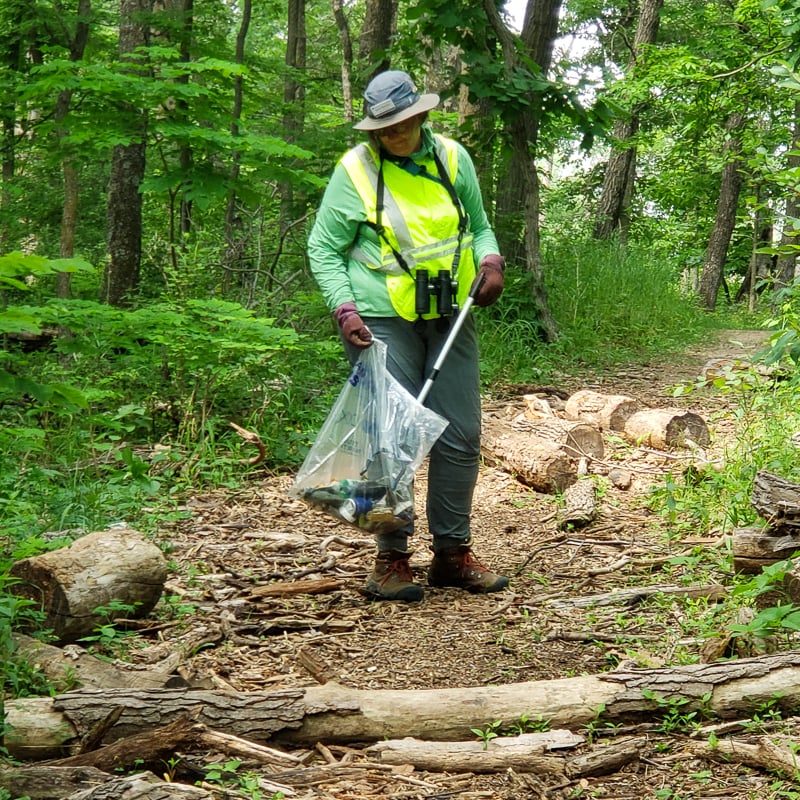
Saturday, April 26, 9 a.m.-noon: Sand Point Trail cleanup: Weather and river level permitting, a bunch of us will head out along one of Frontenac State Park’s most popular trails to pick up litter. Please join us! We’re friendly, or if you just want to be left alone to stab litter, we’re good with that, too. Bonus? You’ll see and hear lots of great birds. Stop by our table in the little parking lots across from the trailhead anytime between 9 and noon to pick up supplies … and TREATS! Questions? Email jeneannnolting@gmail.com.
Saturday, April 26: Frontenac State Park Association will have an information table at the Bluebird Expo in Red Wing.

Saturday, May 3, 10 a.m.: Workshop on bird apps: This is a workshop for people who want to learn how to use the fun, free apps Merlin and eBird to deepen their appreciation and enjoyment of birds. Merlin helps you learn to identify the birds you are hearing and seeing. eBird keeps track of your sightings, helps you figure out where others are seeing birds, and functions as a global citizen science project focused on birds. At this workshop, we’ll learn how to navigate the apps on our phones and then we’ll go outside to use them. The workshop is free but limited to 15 participants. Register here.
Tuesday, May 6, 10-11 a.m.: Nature Explorers class on dragonflies for preschoolers. Join instructor Sara Holger and FSPA volunteers for a merry hour of fun and learning at and outside the main picnic shelter. Children must be accompanied by an adult.
Saturday, May 10, 9-11 a.m.: Guided bird walk: Meet at the Sand Point Trail parking lot, then walk through the riparian forest and along the beach to Sand Point. Warbler migration! We will look for migrants such as the Blackburnian Warbler and Northern Waterthrush as well as residents such as the Prothonotary Warbler and American Redstart. Listen for the ethereal call of a Wood Thrush. Bring binoculars. The trail is well maintained and flat. The full loop is approximately 2 miles long, but you can head back whenever you need to. Questions? Email janetmalotky@gmail.com.
Thursday, May 15, 3-4:30 p.m.: Quarterly meeting of the Frontenac State Park Association at the main picnic shelter. Interested in joining us? Stop by, or email chair Steve Dietz at stevedietz@duck.com.
Sunday, May 18, 11 a.m.-12:30 p.m.: Guided fungi walk: Meet at the campground kiosk for a walk in which we’ll talk about wild fungi and their relationship to trees, and see if we can find anything interesting. While May is traditionally a good month to find morels, we guarantee nothing except that you’ll learn a few things for searching on your own, too. Wear shoes and socks, long pants and sleeves, and bring tick protection. Questions? Email Pamela Miller at pamelamarianmiller@gmail.com.
Saturday, May 24, 10-11 a.m.: Guided nature walk: Meet at the campground kiosk for the first walk of the season guided by interpretive naturalist Bruce Ause. Bruce’s walks are by far our most popular offering. Come see why!
Sunday, May 25, 11 a..m.-1 p.m.: Raptor program with biologist Jackie Fallon. Meet at the ranger station.
Saturday, May 31: Volunteer event with Great River Greening: planting, seeding and removing invasive species in the park. If you’d like to help, go to their website to register.
Birdnote: Dance like no one’s watching
By Janet Malotky, Minnesota Master Naturalist volunteer
Every April, a wacky bird glides into the forest edges of Frontenac State Park to once again bid for a mate and the continuation of the species –- long may they live! I’m talking about the American Woodcock, also known as the Timberdoodle, among other nicknames. They arrive from their wintering grounds in the southeastern United States and hit the ground … strutting? If you want to be delighted, click on this link to see the Woodcock taking a stroll.
The reason for this fancy walking style is not understood, though some wonder whether the rhythm drives their underground prey (worms, larvae, insects) to reveal themselves somehow. It doesn’t seem to be related to courtship rituals, as Woodcocks have acrobatic aerial displays for that purpose. But hey, it’s springtime, and maybe they’re just feeling jaunty.
Woodcocks are chubby grackle-sized birds with ridiculously long bills. They spend most of their time on the ground in areas of moist forest duff. We met their mudflat-dwelling cousins, the Wilson’s Snipes, in the October 2023 Bird Note. Like Snipes, Woodcocks probe deep into the soil with their sensitive, pliable bills to locate prey, which they slurp up while the bill is still underground. Their eyes are weirdly located high and toward the back of their head, giving them a wide field of vision, even when their bills are stuck deep into the soil. The female nests in a shallow depression on the forest floor, where she is exquisitely camouflaged.
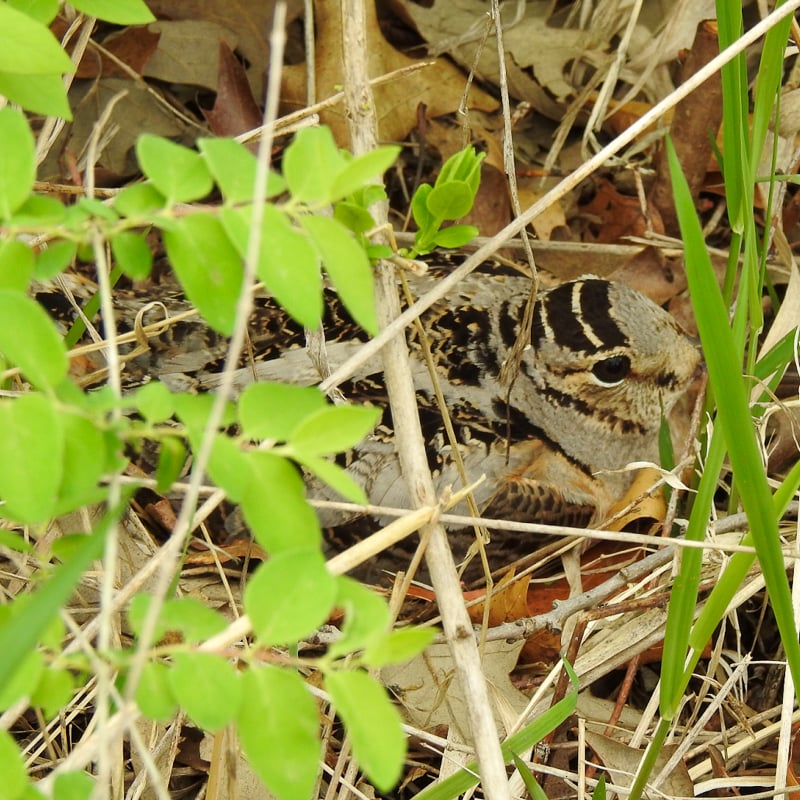
Because of their excellent camouflage, Woodcocks are rarely seen in the wild. Your best chance to see one is during their aerial courtship displays. Almost every evening just after sunset, Woodcocks make their way from forest edge to open field/meadow/prairie. There the male begins to “peent.” He peents several times to let everyone know he’s there, and then he leaps into the air to begin his spiraling ascent high above the prairie floor. As he rises, the air rushing through his feathers makes a twittering sound (first part of recording). At the apex of his rise, he pauses, probably hoping a female is watching, before plummeting toward the ground in a freefall while chirping rapidly (last part of recording).
Is he chirping in terror? Just shy of impact, though, he resumes control and lands gently, often exactly where he took off, only to resume peenting. He then repeats the whole sequence again and again, continuing through the evening and sometimes through the night. Once courtship has been successful, the female makes a nest, lays and incubates the eggs, and feeds the young on her own. The male has put all his energy into flirtation.
I mentioned that we can experience this display in the park, and we can. However, as also mentioned, it happens after sunset. Our eyes are not our strongest asset in this setting. On a bright night, I have glimpsed only the silhouette of a Woodcock at different points during the display. But fortunately the entire sequence can be heard.
It’s pretty neat to go out on the prairie as twilight turns to dark and rely on just your hearing. A little spooky if the coyotes are also yipping. But remember, coyotes don’t eat people! They would love to eat a noisy Woodcock, though. Fortunately, Woodcocks can fly.
Notes from the field: Not mourning the Mourning Cloak
By Steve Dietz, Minnesota Master Naturalist volunteer

As Kenn Kaufman writes in his “Field Guide to Butterflies of North America,” “for winter-weary northerners, few sights can be as welcome as that of the first Mourning Cloak emerged from its hibernation, gliding through leafless woods during the first spring thaw.” That’s now, folks! What’s to mourn about butterflies in April?
In almost every butterfly guide, the Mourning Cloak is described as not looking like any other butterfly. It is large, with a wingspan of up to 4 inches. When open, the wings appear red/brown surrounded by a black margin containing bright blue spots. The outer edges are yellow.
When its wings are closed, however, the undersides of the wings are a mottled gray-brown with the same yellow edge. To us, this side looks like a dead leaf or tree bark, but apparently to many observers in the 18th century, it appeared similar to a mourning cloak. As entomologist Leonard Newman put it, the butterfly's pattern is like a girl who, disliking having to be in mourning, defiantly lets a few inches of a bright dress show below her mourning dress.
The Mourning Cloak is remarkable for much more besides its name, unique looks and early appearance. It is among the longest-living butterflies, with a lifespan of over 10 months. First-generation adults hibernate over winter and emerge in early spring to mate. The female lays eggs in groups circling twigs of the host plant. Caterpillars live in a communal web and feed together on young leaves, then pupate and emerge as adults in June or July. After feeding briefly, the adults estivate — go into a dormant or torpid state during a hot dry period — until fall, when they re-emerge to feed and store energy for hibernation.
Mourning Cloaks feed on tree sap, rotting fruit, dung, mud, but only occasionally on flower nectar. In Minnesota, they will walk down the trunk of a tree to the patterned holes drilled by a Yellow-bellied Sapsucker and dip their proboscis into the flowing sap from above — presumably so they aren’t entrapped in the viscous fluid to become a meal themselves.
I’m excited to look for all of these life stages of the Mourning Cloak.
Why are there more black bears across the river?
By Pamela Miller, Minnesota Master Naturalist volunteer
It’s long puzzled us that black bear sightings are quite common just east of us, across the Mississippi River in the bluff, woodlands and pasture areas of western Wisconsin. Here in Minnesota, just west of the Mississippi? They’re rare. Why is that? Did the bears figure out that Spotted Cow is much better than Hamm’s? Did Packers fans kidnap them all?
We reached out to FSP manager Jake Gaster, whom we enjoy pestering with all manner of nonurgent questions. He had an answer for us. But first, here are a couple of maps that show the distribution of black bears (Ursus americanus) in Minnesota and Wisconsin:
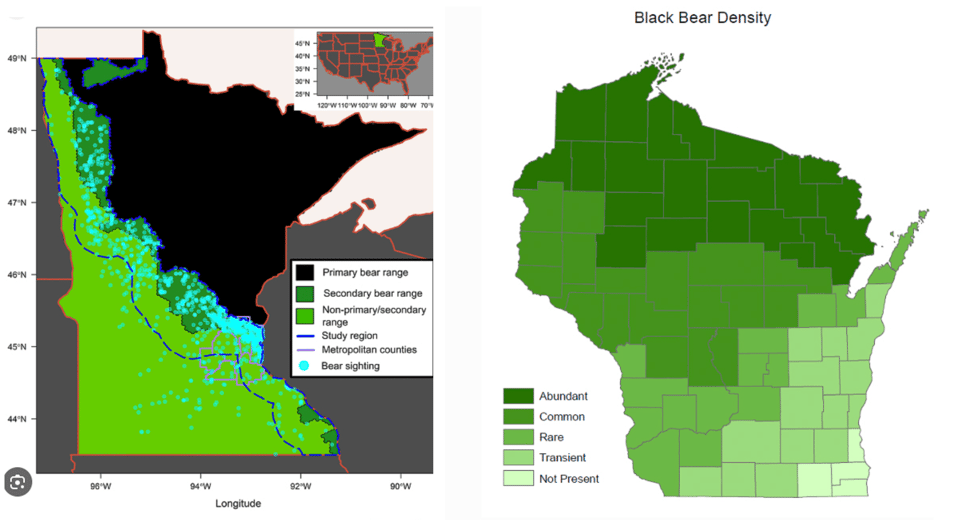
As you can see, black bear sightings in our area are few. Across the river, they’re far more likely. Why?
Says Jake: “There are two primary reasons for the observation of more bears on the Wisconsin side of the river relative to here – namely, proximity to core bear habitat and habitat connectivity. The core forest habitat for bears is much nearer to the river on the Wisconsin side than in Minnesota, as you can see in the map snippets.
“Additionally, the Minnesota side of the Mississippi and St. Croix rivers is more heavily urbanized than in Wisconsin, from the Twin Cities down through our area. That removes the habitat corridors through which wildlife typically travel. There is just more habitat and undeveloped habitat corridors through which bears can travel on the Wisconsin side of the river.”
Makes sense, eh? Habitat corridors are vitally important for all wild creatures, and ever more threatened around the world. And yet … now and then, someone spots a black bear padding across a mud flat near Prairie Island or in a remote part of Frontenac State Park, or, even once recently, near the front door of the Red Wing Police Department. In the unlikely event you spot one in our park, slow down, back off, and call ranger Jake at 651-299-3000. The park would do all it could to make sure it’s unbothered and safe.
Side note: The Minnesota Star Tribune had a pretty good little story recently about black bears. Here’s a gift link.
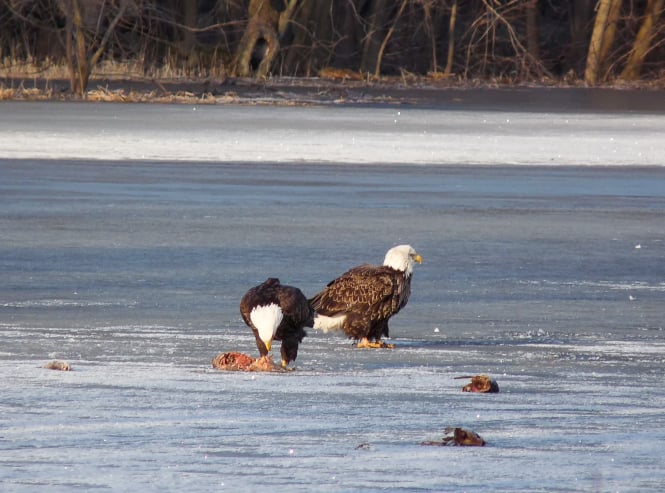
Bruce Ause’s blog: Signs of spring, and some startling sights
As we do every month now, we want to refer you to friend of the park Bruce Ause’s fascinating nature blog. (As mentioned in our events calendar above, Bruce soon will resume his popular Saturday morning walks from the campground.) Bruce, who lives just northeast of the park’s remote Rattlesnake Bluff, covered a range of topics in his March posts, some of them a tad startling. Here’s a taste from one entry: “Eagles and other scavenging birds frequently start by eating the eyes first. Soft tissue is considered a delicacy in the carrion world. This phenomenon is similar to vultures going after the internal organs first when feeding on carcasses.” Good to know … maybe! For more riveting reading, check out Bruce’s blog.
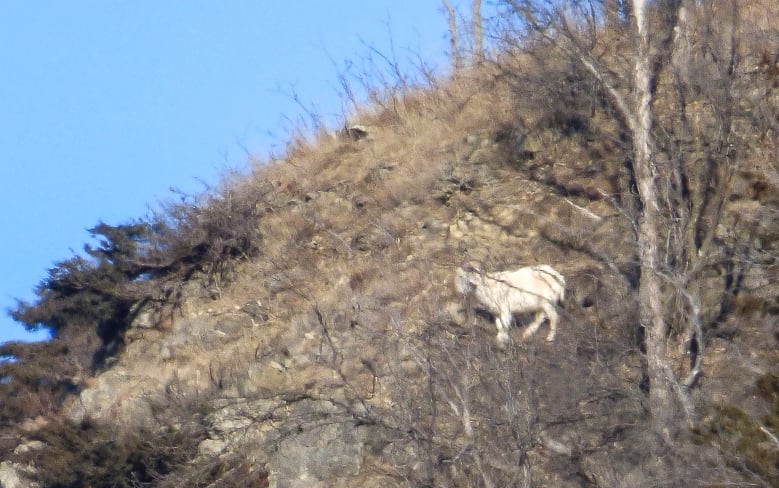
White Lightning lives on
Our newsletter is a low-key publication, never aiming to go viral, especially because to us nature ’n’ science types, the word “viral” is not a pretty concept. But, say! If ever, in the modern digital sense of the word, we’ve gone viral, it’s in reporting on the fortune of the buckthorn-eating goat who escaped from a paddock up on the park’s remote Rattlesnake Bluff back in fall 2023. To our amazement, White Lightning has now survived two winters up there, where we hope he is relishing every sprig of buckthorn he encounters. In the past two weeks, we’ve had three solid sightings of White Lightning, including one by your newsletter editor, who needs to drive more carefully, we must say. If you’re driving past Rattlesnake Bluff on Hwy. 61 south of Wacouta Pond, CAREFULLY glance up at the bluffside. See a bright white spot? That’s our White Lightning. Long may he roam!

Poem of the month
“AN APRIL DAY”
By Henry Wadsworth Longfellow
(American; 1807-1882)
When the warm sun, that brings
Seed-time and harvest, has returned again,
'T is sweet to visit the still wood, where springs
The first flower of the plain.
I love the season well
When forest glades are teeming with bright forms,
Nor dark and many-folded clouds foretell
The coming-in of storms.
From the earth's loosened mould
The sapling draws its sustenance, and thrives;
Though stricken to the heart with winter's cold,
The drooping tree revives.
The softly-warbled song
Comes through the pleasant woods, and coloured wings
Glance quick in the bright sun, that moves along
The forest openings.
When the bright sunset fills
The silver woods with light, the green slope throws
Its shadows in the hollows of the hills,
And wide the upland glows.
And when the eve is gone,
In the blue lake the sky, o'er-reaching far,
Is hollowed out, and the moon dips her horn,
And twinkles many a star.
Inverted in the tide
Stand the gray rocks, and trembling shadows throw,
And the fair trees look over, side by side,
And see themselves below.
Sweet April! -- many a thought
Is wedded unto thee, as hearts are wed;
Nor shall they fail, till, to its autumn brought,
Life’s golden fruit is shed.
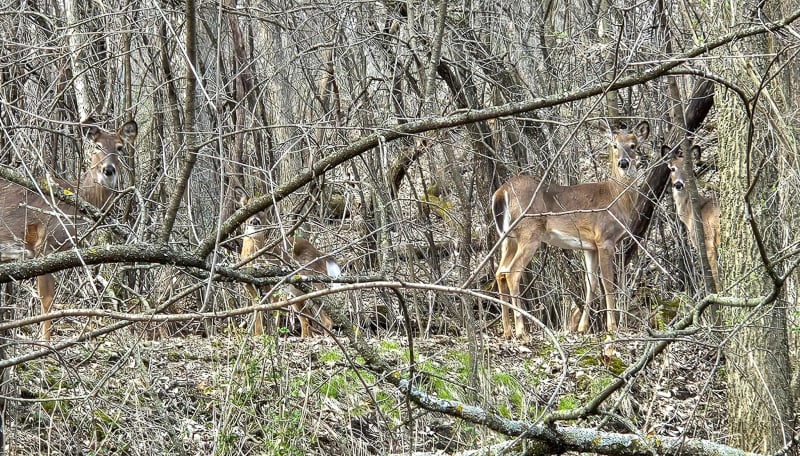
Interested in joining the FSPA?
If you were a member in 2024, thank you! You allowed us to pursue our mission of supporting this treasured park with service days, new bird amenities, a new park sign, and many interpretive outings.
Membership is on an annual basis. If you have not yet renewed, please do so. If you’d like to join us, we’d be honored to have your support. Dues are $25 per year for an individual, $35 for dual/family membership. Here’s a link with signup information.
A reminder that joining us occasionally to help with volunteer efforts is awesome too, even if you’re not a member. The FSPA’s goals are to support the park and share our love of Frontenac State Park with as many people as possible.
To sign up to regularly receive this free, spam-free monthly newsletter, click on “Subscribe” below. Feel free to send questions or comments to your newsletter editor at pamelamarianmiller@gmail.com. Questions about the FSPA? You can reach hard-working FSPA chair Steve Dietz at stevedietz@duck.com.

Handy links for more information and education
Frontenac State Park Association
If you take pictures in the park, tag us on Instagram
Frontenac State Park bird checklist
Frontenac State Park on iNaturalist
Parks & Trails Council of Minnesota
Website for our township, Florence Township
Minnesota Master Naturalist programs
Red Wing Environmental Learning Center
Lake City Environmental Learning Program on FB

Frontenac State Park staff
Jake Gaster, park manager; Amy Jay, assistant park manager; Amy Poss, lead field worker
Parting shot

Thank you, readers and park visitors!
This is Volume 3, No. 4 of the Frontenac State Park Association newsletter, which was launched in April 2023.
Here’s where to browse the full archives of this newsletter.